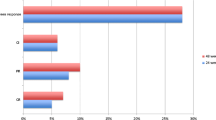Summary
Current literature provides conflicting evidence regarding the efficacy of lenalidomide in patients with myelofibrosis (MF). The aim of this work was to evaluate the efficacy of lenalidomide in patients with MF treated within a named patient program in Austria. A total of 22 patients with MF were treated with lenalidomide in 7 different centres throughout Austria. Median age of patients was 68 years. Primary MF was present in 13 patients. Eight patients had post-polycythemia vera (post-PV) and 1 post-essential thrombocythemia (post-ET) MF. According to the Dynamic International Prognostic Scoring System (DIPSS), all patients were scored within the intermediate-2 or high-risk group. Approximately one-third of patients were treated with 2 or more prior therapies. The overall response rate according to International Working Group (IWG) criteria was 12.5 %. Efficacy of lenalidomide was moderate in this non-study patient population. Limiting factors seemed to be stage of disease and risk profile of patients included in this analysis.
Zusammenfassung
Die Wirksamkeit von Lenalidomid bei Patienten mit Myelofibrose stellt sich in der Literatur nicht ganz einheitlich dar. Das Ziel dieser Arbeit war die Wirksamkeit von Lenalidomid in einer „real world“ Population von Patienten mit Myelofibrose zu evaluieren, die das Medikament im Rahmen eines „named patient“ Programms in Österreich zur Verfügung gestellt bekamen. Das mediane Alter der 22 eingeschlossenen Patienten betrug 68 Jahre. Dreizehn Patienten hatten eine primäre Myelofibrose, 8 eine post-Polycythämia vera- und ein Patient eine post-Essentielle Thrombocythämie–Myelofibrose. Die teilweise schwere Vorbehandlung spiegelte sich im Risikoprofil (Dynamic International Prognostic Scoring System) wider, in dem alle Patienten in der intermediate-2 oder Hochrisikogruppe vertreten waren. Die Gesamtansprechrate lag bei 12,5 %, sodass von einem moderaten Ansprechen auf Lenalidomid in dieser Patientenkohorte auszugehen ist. Limitierende Faktoren scheinen das fortgeschrittene Stadium der Erkrankung sowie das Risikoprofil der Patienten darzustellen.
Similar content being viewed by others
References
Tefferi A, Thiele J, Orazi A, Kvasnicka HM, Barbui T, Hanson CA, Verstovsek S, Birgegard G, Mesa R, Reilly JT, Gisslinger H, Vannucchi AM, Cervantes F, Finazzi G, Hoffman R, Gilliland DG, Bloomfield CD, Vardiman JW. Proposal and rationale for provision of the World Health Organization diagnostic criteria for polycythemia vera, essential thrombocythemia, and primary myelofibrosis: recommendations from an ad hoc international expert panel. Blood. 2007;110:1092–7.
Cervantes F, Dupriez B, Pereira A, Passamonti F, Reilly JT, Morra E, Vannucchi AM, Mesa RA, Demory JL, Barosi G, Rumi E, Tefferi A. New prognostic scoring system for primary myelofibrosis based on a study of the International Working Group for Myelofibrosis Research and Treatment. Blood. 2009;113:2895–2901.
Cervantes F, Mesa R, Barosi G. New and old treatment modalities in primary myelofibrosis. Cancer J. 2007;13:377–83.
Harrison C, Kiladjian JJ, Al-Ali HK, Gisslinger H, Waltzman R, Stalbovskaya V, McQuitty M, Hunter DS, Levi R, Knoops L, Cervantes F, Vanucchi AM, Barbui T, Barosi G. JAK Inhibition with ruxolitinib verus best available therapy for myelofibrosis. N Engl J Med. 2012;366:778–98.
Verstovsek S, Mesa RA, Gotlib J, Levy RS, Grupts V, DipPersio JF, Catalano JV, Deininger M, Miller C, Silver RT, Talpaz M, Winton EF, Harvey JH, Arcasoy MJ, Hexner E, Lyons RM, Paquette R, Raza A, Vaddi K, Ericson-Viitanen S, Koumenis IL, Sun W, Sandor V, Kantarjian HM. A double-blind, placebo-controlled trial of ruxolitinib for myelofibrosis. N Engl J Med. 2012;366:799–807.
Tefferi A, Cortes J, Verstovsek S, Mesa RA, Thomas D, Lasho TL, Hogan WJ, Litzow MR, Allred JB, Jones D, Byrne C, Zeldis JB, Ketterling RP, McClure RF, Giles F, Kantarjian HM. Lenalidomide therapy in myelofibrosis with myeloid metaplasia. Blood. 2006;108:1158–64.
Quintas-Cardama A, Kantarjian HM, Manshouri T, Thomas D, Cortes J, Ravandi F, Garcia-Manero G, Ferrajoli A, Bueso-Ramos C, Verstovsek S. Lenalidomide plus prednisone results in durable clinical, histopathologic, and molecular responses in patients with myelofibrosis. J Clin Oncol. 2009;27;4760–6.
Mesa RA, Yao X, Cripe LD, Li CY, Litzow M, Paietta E, Rowe JM, Tefferi A, Tallman MS. Lenalidomide and prednisone for myelofibrosis: Eastern Cooperative Oncology Group (ECOG) phase 2 trial E4903. Blood. 2010;116:4436–8.
Tefferi A, Barosi G, Mesa RA, Cervantes F, Deeg HJ, Reilly JT, Verstovsek S, Dupriez B, Silver RT, Odenike O, Cortes J, Wadleigh M, Solberg SA, Camoriano JK, Gisslinger H, Noel P, Thiele J, Vardiman JW, Hoffman R, Cross NC, Gilliland DG, Kantarjian H. International Working Group (IWG) consensus criteria for treatment response in myelofibrosis with myeloid metaplasia, for the IWG for Myelofibrosis Research and Treatment (IWG-MRT). Blood. 2006;108:1497–1503.
Burgstaller S, Wimmer S, Mayrbäurl B, Hoebling W, Thaler J. Coexistence of primary myelofibrosis and chronic lymphocytic leukaemia—treatment of two different diseases with one agent. Blood Cancer J. 2011;1:e20; doi:10.1038/bcj.2011.18.
Jabbour E, Thomas D, Kantarjian H, Zhou L, Pierce S, Cortes J, Verstovsek S. Comparison of thalidomide and lenalidomide as therapy for myelofibrosis. Blood. 2011;118:899–902.
Conflict of interest
The authors declare that there is no actual or potential conflict of interest in relation to this article.
Author information
Authors and Affiliations
Corresponding author
Rights and permissions
About this article
Cite this article
Burgstaller, S., Fridrik, M., Hojas, S. et al. Experience with lenalidomide in an Austrian non-study population with advanced myelofibrosis. Wien Klin Wochenschr 125, 196–199 (2013). https://doi.org/10.1007/s00508-013-0345-z
Received:
Accepted:
Published:
Issue Date:
DOI: https://doi.org/10.1007/s00508-013-0345-z



